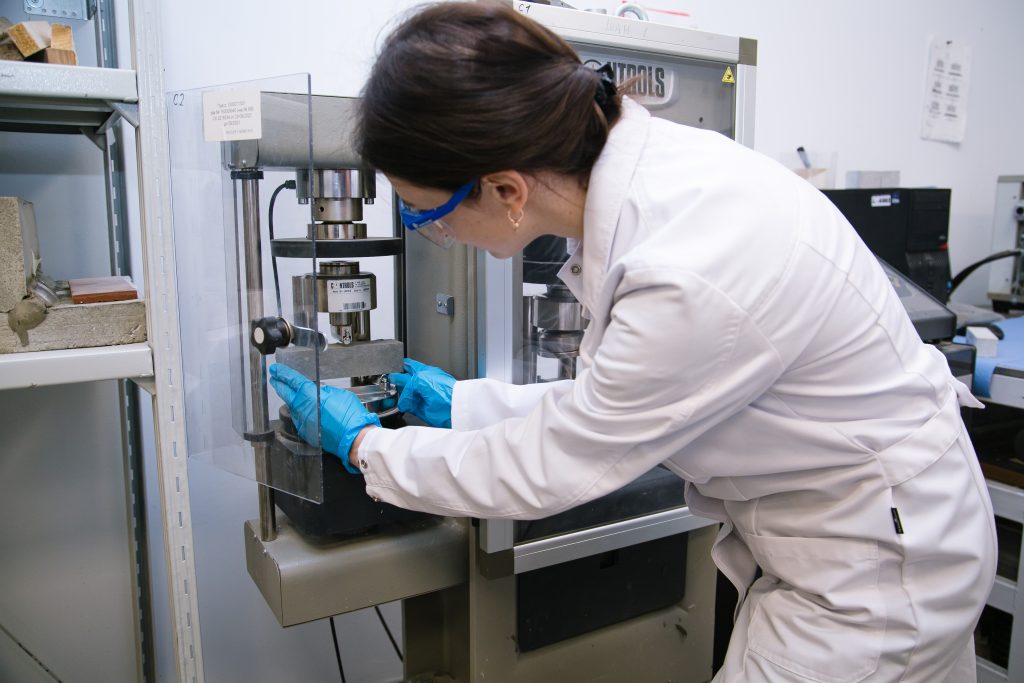UHPC Technology
UHPC is a class of concrete defined by its exceptionally high flexural and compressive strength. UHPC was first developed in the early 1980’s and since then has been used for applications needing exceptional strength and durability like nuclear power plants, thin-profile bridges, structural beams and seawall anchor plates.UHPC derives its high performance from a carefully calibrated ratio of engineered ingredients and a mixing sequence that packs molecules closely together to create very tight bonds. The high packing density yields excellent flexural, compressive, and impact strength. Because the molecules are so tightly packed, the capillary pores that exist in traditional concrete are eliminated.
The basic raw materials of UHPC are concrete, water, sand, cement, silica fume, and plasticizers. However, UHPC is an order of magnitude different from traditional categories of concrete. No special resins, cellulose, or polymers are used to achieve the outstanding properties of architectural UHPC.

Rather, the distinction lies in the size, geometry, and carefully selected chemistry of extremely small particles that combine under exacting mixing, vibration, and curing regimens to form a base matrix.
This new advanced cementitious material; the UHPC has opened the door to many potential applications and proved to be a viable solution for improving the sustainability of architecture.
Although UHPC is higher in production cost, it would be more realistic to look at the costs on the basis of the entire project. Due to its high strength one is able to use panels that are smaller in cross sectional area (slender and light structural or façade components) thus leading to savings in prestressing and reinforcing steel.
UHPC has good workability, low creep and shrinkage losses, and high wearing resistance. Its excellent durability results in longevity
of structures and a reduction in overall maintenance or repair costs. UHPC posses ceramic properties such as impermeability to water, heat resistant, and surface behaviors making it ideal for usage in high strength applications.
Development
Concrete technology has made remarkable advances in recent decades. Over the past 15 years, many working in this field have developed ultra-high-performance concretes (UHPC) up to a level where they are ready for application – and with compressive strengths from about 90 to 185 Mpa, which are almost near to steel. Reinforced with fine steel/stainless steel fibres with a high tensile strength, such concretes become ductile and reach tensile strengths exceeding 15 Mpa (really exceptional for concrete) and flexural tensile strengths of up to 40 Mpa. So, this type of concrete can for the first time be designed to accommodate tension, and by using new design principles suited to this material, with or without traditional reinforcement, the result is forms of concrete construction that save materials and are sustainable.
The other advantage of UHPC over conventional concrete is its very low porosity. UHPC exhibits a much denser microstructure with virtually no capillary pores and is therefore so impervious to liquids and gases that its corrosion is practically zero. Owing to UHPC’s good durability, its materials saving composition and the low maintenance required, structures made from UHPC, when properly designed, are also considerably more cost-effective than comparable structures made from normal strength concrete. Therefore, a wide range of applications can now be covered very economically.
Basic Material Concepts
Microstructure Properties
The excellent performance of UHPC – when compared with normal-strength or even high- strength concretes – is predominantly due to its much denser hardened cement matrix with virtually no capillaries.
Furthermore, easy-flowing UHPC is a fine -grained mix, with a maximum particle size of 1 mm. Therefore, its internal microstructure is much more homogeneous than customary, coarse- grained concretes and it is essentially more uniformly stressed by external actions. Together, these two aspects result in the compressive strengths of about 90–200 Mpa so typical of UHPC. Even in the case of the coarse-grained UHPC that has been developed in the meantime for various applications, the differences in the strengths and deformation behaviours of the matrix and the aggregate are so small that any cracks that do form propagate in a straight line through the matrix and the aggregate. That in turn means that UHPC has distinctly brittle failure behaviour. Whereas normal-strength concrete exhibits an increasingly ductile behaviour as compressive stresses rise due to changes to the internal microstructure and still retains a load bearing capacity even after its strength is reached, unreinforced UHPC fails abruptly.
Nevertheless, UHPC can still be used to build safe structures provided it is reinforced with fine high- strength steel fibre (and conventional or prestressed reinforcement if required). With a sufficiently high fibre content, the tensile strength of UHPC can be improved and ensured to such an extent that structural components in tension are possible without any further reinforcement. The very dense microstructure and high strength so typical of UHPC are due to its very low water/ binder ratio (cement, silica fume and further reactive substances if required) of only about 0.20. The matrix therefore has practically no capillaries and is thus diffusion- resistant.
Another factor contributing to the high strength is the fact that the ultra fine particles (grain size <125 μm) consist of various components (cement, quartz powder, silica fume plus further inert or reactive fine fillers if required) that are combined in such a specific way that the ultra fine particles are packed very tightly together.
The matrix therefore has practically no capillaries and is thus diffusion-resistant.
